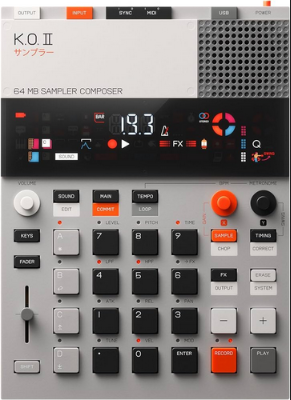We had a nice Thanksgiving trip to visit my in-laws. They have a very entertaining 5-month old puppy who defies gravity to lick faces and ears, and we’ve got a cute nephew, and the food was all good and the drive wasn’t too bad. So that was pretty pleasant!

Teenage Engineering announced some ridiculous, mysterious overpriced thing (executive desk toy maybe?) called the Grip Car that caused people to make fun of them again… and then the very next day, announced the “EP-133 K.O. II” sampler/drum machine, which expanded on the very small, flimsy, toylike Pocket Operator sampler. But this incarnation is a hybrid of retro desktop calculator, toy, and modern groovebox. Compact and yet generously sized for playing. Those buttons have velocity and pressure sensors, and there are built in effects, the ability to record unquantized, record fader movements, built-in filters and effects and a live performance sort of attitude overall. It is exceedingly clever, and priced at the bottom end of sampling grooveboxes. The first production run sold out very quickly but I went for it. It also shipped almost immediately and was waiting for me when we got home from our trip.
Apparently the project was conceived by buying a whole bunch of available off-the-shelf parts while hedging against parts shortages, then designing something around it. So that’s part of how they kept costs down. The display, aside from the text segments in the center, is just plain LEDs with a color overlay. (There’s kind of an overwhelming amount of status lights going on at times and I end up tuning out most of it, but it doubles as a fun light show when using the punch-in effects.) Weird as this is to say, it is partially Lego-compatible — the pot shafts and slider are axles, the nameplate/battery cover and the speaker grill are attached with Lego-like studs and there are holes on the side where connectors could snap in (maybe for a stand or to link multiple units together — this is supposedly the first in a series using this form factor).
There have been several reports about non-working faders. This is probably due to the packaging — it’s an extremely tight fit, single-wall thin cardboard box, not as rigid or generally protective as it should be. Some people have been able to DIY a repair with a bent paper clip. Thankfully mine works without issues.
The sound is great at the price, and it’s a lot of fun to play and put stuff together. Hip-hop producers are having a field day with it, and I’m able to get some wonky droney ambient stuff going as well as deep dubby beats and the like, just with the included samples. Sampling the modular, DAW, and other toys should work out very nicely.
It doesn’t do x0x style sequencing, where you pick (for instance) the hi-hat and press buttons to choose which steps they land on. Instead, if you don’t want to record live, you can navigate to the step you want using the +/- buttons and then choose which pads are played on that step. It kind of makes sense, it’s just like live recording but paused. For live stuff, it’ll record unquantized if you want it to, and you can punch in time-correction and even swing, which is pretty unique but really nice to have. You can also manually and very precisely shift steps to nail down just the right groove.
There are a few things that seem weird until you get used to them, but the adjustment period is pretty short. There are also inevitable hidden button combos and config settings with cryptic code numbers, so it’s not a 100% manual-free experience by any means. But for the most part it’s simpler and more immediate than Elektron boxes tend to be.
There are limitations, most of which don’t concern me. 64mb of total memory, which is tiny in 2023 but is really more than sufficient for what the box does. Apparently no way to transfer patterns/scenes to a computer — since I’ll just be using this for screwing around or for temporary things I don’t mind that. No resampling but that’s not common in cheaper devices anyway. No sample loop points for sustained sounds, but apparently that’s coming. There’s only one master effect at a time (delay, reverb, distortion, a resonant LPF, or compression) plus the LPF/HPF per group and live punch-in FX; I feel like the distortion and reverb would have complimented each other nicely, but since I’ll be integrating it with my other gear when not just goofing around with it, that’s no big deal anyhow.
The only real shame is the way the packaging has caused all these slider failures in transit. They probably paid a good bit to license the Muhammad Ali photos and make the box look very nice, it’s just not functionally protective enough.
The closing for my parents’ house is Thursday. We need to do a lot of little things to help out — the final walkthrough, getting the keys, changing locks, taking some detailed measurements, picking up packages and delivered furniture (from Black Friday sales), being there for the alarm guy, etc. I’ve also got to do a bit more Christmas shopping, and take my car in for service this weekend (Check Engine light, but it’s also nearing the 80K mile service.)

